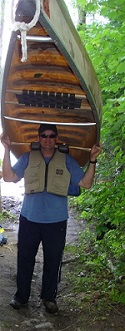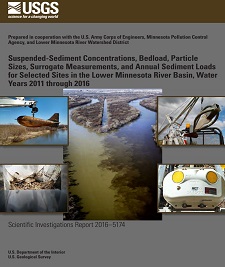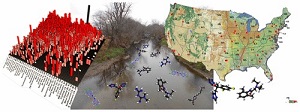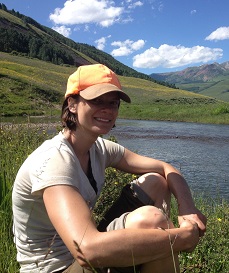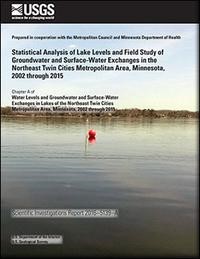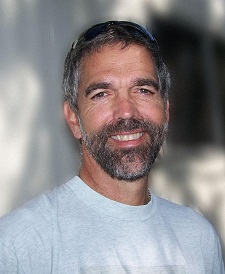 Minnesota Water Science Center Newsletter Spring 2017 View on our webpage |
U.S. Department of Interior U.S. Geological Survey Minnesota Water Science Center 2280 Woodale Drive Mounds View, MN 55112 http://mn.water.usgs.gov |
|||||||||||
From the Director
I'm not completely going away. I'll continue to be involved in the Lake Superior and Rainy- Lake of the Woods bi-national watershed boards. In addition, I'll stay involved in technical advisory committees focused on sustainable water supplies for the Metropolitan Twin Cities. Away from the office, I will keep busy with my family and grandkids, volunteer activities, basketball refereeing, and as a board member of the Minnesota Land Trust. During my career I have survived many USGS reorganizations and changes in national priorities. My career has been enhanced by many bosses, mentors, and colleagues. From these individuals I have learned a great deal. Changing priorities, evolving projects, and reviews of budgets, reports, and programs have been part of the job. The blessing, however, has been working with and being able to know many special people in the water-resource community within and beyond the USGS family. I take great satisfaction in seeing the progress that Minnesota is making in protecting and improving the waters of our State. It has been an honor for our staff to be a part of the work funded by the Clean Water, Land and Legacy Amendment to the Minnesota Constitution that protects, enhances, and restores, streams, lakes, wetlands, and groundwater. I also take great pride in seeing the contributions that the many USGS student interns have made, over the years, on water challenges faced by the State and the Nation. It has been a good ride! I hope to see you around at water meetings as we celebrate the good work that you all are doing for the citizens of our great State. Jim New Minnesota Water Science Center reportsContaminants of Emerging Concern (CECs) in the Great Lakes Basin
Contact: Sarah Elliott, selliott@usgs.gov The second report resulted from collaboration with the U.S. Fish & Wildlife Service. USFWS has led a multi-pronged study of risks posed by CECs to fish and wildlife in the Great Lakes Basin. As part of this study, USGS assisted with sampling and interpretation of CECs in water and sediment in U.S. tributaries to the Great Lakes. The first interpretive report from this collaboration was published in late January as the USFWS report Contaminants of emerging concern in the Great Lakes Basin: A report on sediment, water, and fish tissue chemistry collected in 2010-2012. Mark Brigham, Sarah Elliott, and Kathy Lee (all with MN WSC) were co-authors. Contact: Sarah Elliott, selliott@usgs.gov Mercury and lake levels in Voyageurs National Park
Contact: Victoria Christensen, vglenn@usgs.gov Suspended Sediment in the Lower Minnesota River
Contact: Joel Groten, jgroten@usgs.gov Significant national reportsFrom Minnesota to the Gulf of Mexico--The challenge of tracking nutrient pollution 2,300 milesThe USGS issued a press release on March 6, on the Spatially Referenced Regression on Watershed At tributes (SPARROW) model, and its use to estimate nutrient yields and identify hotspots of nutrient loading within the Mississippi River Basin. The release quotes the Minnesota Pollution Control Agency's Dave Wall. Full press release. Trends in water quality
The Surface-Water Trends team of the USGS National Water Quality Asssessment (NAWQA) project has determined over 10,000 trends at almost 1,400 sites monitored by 74 organizations across the United States. These trends are presented in an online mapper that displays changes in the quality of the Nation’s rivers and streams since passage of the Clean Water Act in 1972. Data preparation, statistical methods, and trend results from the study are documented in the companion Scientific Investigations Report 2017–5006. Local, State, Tribal, and Federal organizations as well as the public and other stakeholders can use the online mapper and companion report to determine whether 51 chemical constituents (including nutrients, pesticides, sediment, salinity, and carbon) and 38 measures of aquatic life (including the types and numbers of fish, macroinvertebrates, and algae) have increased, decreased or remained the same at specific sites starting in 1972, 1982, 1992, or 2002 and ending in 2012. Over the next several years, we will be using these trend results to describe the geographic distribution, environmental significance, and major causes of water-quality changes over time throughout the Nation.
Challenges remain in combining data from multiple organizations
Almost 60 percent of previously collected nutrient water-quality records for U.S. rivers and streams have missing or ambiguous reference information. This inconsistency limits the use of these data for assessing water quality across large river basins. Across the country, nearly 14.5 million of the 25 million records collected since 1899 by nearly 500 public and private organizations had missing or ambiguous metadata — the standard descriptive information needed to evaluate whether the amount of a chemical present in the sample is representative and defensible.
Press Release Nationwide study of contaminants of emerging concern in source and treated drinking waterThe USGS Toxic Substances Hydrology Program, in collaboration with the U.S. Environmental Protection Agency, conducted a study to evaluate the presence of contaminants of emerging concern in source and treated drinking water at 24 drinking water treatment plants across the U.S. A suite of papers highlighting results from the study was recently published in Science of the Total Environment. The papers summarize wastewater indicators and inorganic chemicals, pharmaceuticals, microbial pathogens, and estrogenicity in source and treated drinking water samples. Two additional papers report on the value of quality control in trace organic studies and human health significance of the findings. This just in: nationwide assessment of trace organic contaminants
Contacts should be directed to the lead authors of the respective papers (pbradley@usgs.gov and wilson.vickie@epa.gov). |
Staff notesWelcome
Congratulations
Farewell
Geoff Delin has Retired!
In 1990, Geoff was principal investigator for the Minnesota Management Systems Evaluation Area study where he researched fate and transport of agricultural chemicals through unsaturated and saturated sand-plain deposits. From 1995-2008 he was site coordinator on the Bemidji crude-oil spill research project. In addition to site coordination duties, Geoff conducted research on effects of recharge on oil dissolution, multiphase flow processes, and vapor-phase transport of hydrocarbons through glacial deposits. Geoff also was the District’s groundwater specialist from 1994-2008. In 2008 Geoff moved to Denver where he served as a groundwater specialist for the central part of the country. He was an instructor for the Groundwater Field Methods class as well as the Groundwater/Surface-Water Interaction Class. Geoff served on 48 technical groundwater review teams during his service as groundwater specialist. Throughout his career Geoff authored or co-authored more than 70 peer-reviewed reports and gave presentations at more than 30 technical conferences. Geoff’s service to the USGS is greatly appreciated and he will be missed. Geoff plans on serving in an Emeritus capacity following retirement to complete some research for the Bemidji project as well as help with USGS training. Geoff and his wife Ruth plan on some international travel, hiking and enjoying the Colorado Rocky Mountains, as well as spending more time with their children and grandchildren. Passing of Gil Gabanski
Gil worked for several companies and public agencies over the years. Most recently, he worked at Hennepin County in the Contaminated Lands Unit where he helped manage the Environmental Response Fund grant program. Gil had a profound impact on the groundwater and geosciences communities in Minnesota. He was a mentor and friend to many of us. Gil was one of the first scientists that I met when I moved to Minnesota. As he could do so well, Gil showed me how to get involved and taught me how things worked in Minnesota. I am just one of many people who will miss him. I hope we can continue to build on the foundation he helped build for geoscience in Minnesota. --Jim Stark |
